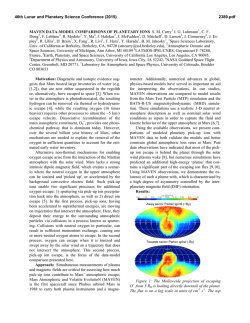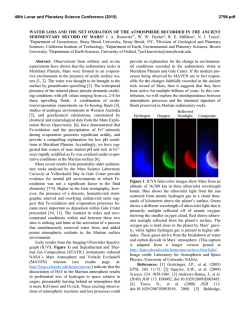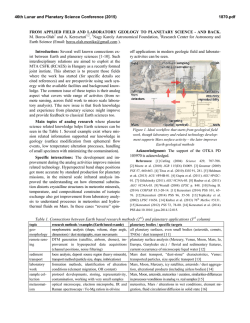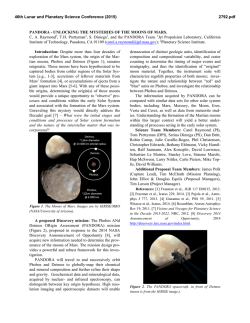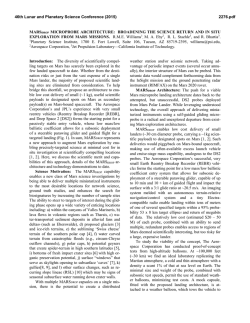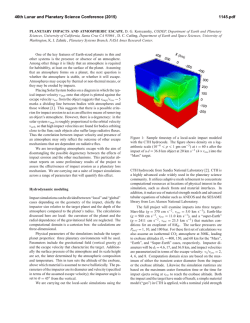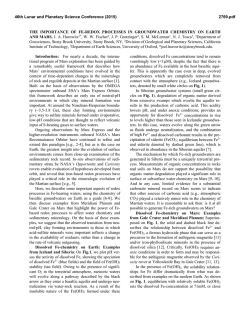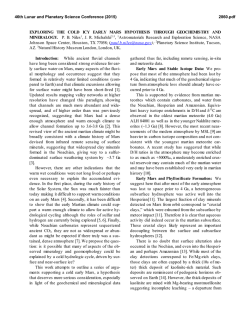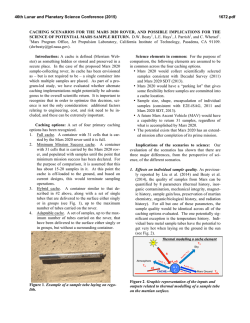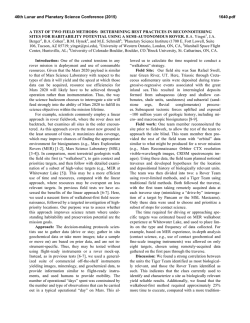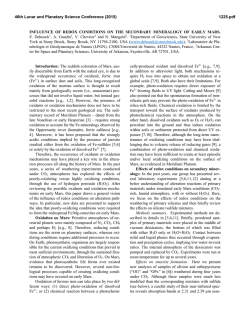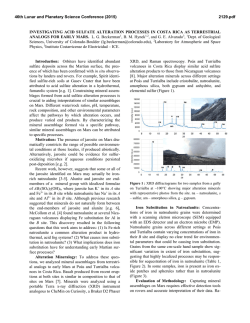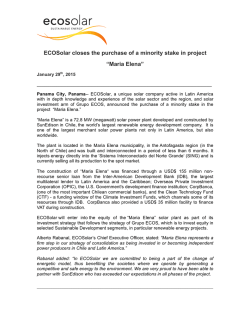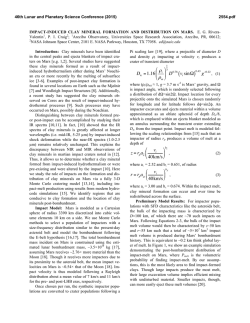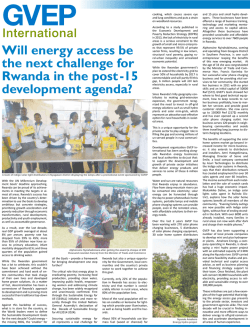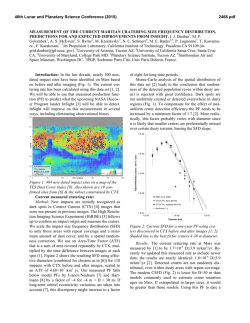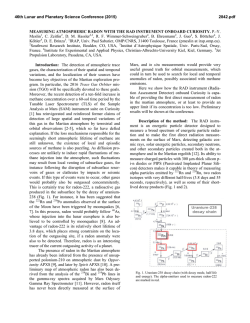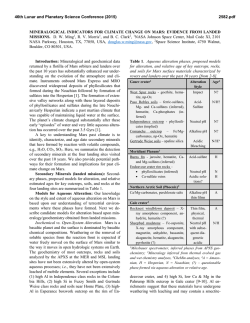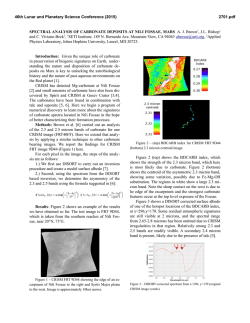
MAVEN MEASUREMENTS OF THE ION ESCAPE RATE FROM
46th Lunar and Planetary Science Conference (2015) 2663.pdf MAVEN MEASUREMENTS OF THE ION ESCAPE RATE FROM MARS. D. A. Brain1, Y. Dong1, K. Fortier1, X. Fang1, J. McFadden2, J. S. Halekas3, J. E. P. Connerney4, F. Eparvier1, C. Dong5, S. W. Bougher5, Y. Ma6, R. Modolo7, R. Lillis2, J. Luhmann2, S. Curry2, K. Seki8, B. M. Jakosky1, 1Laboratory for Atmospheric and Space Physics, University of Colorado, Boulder CO 80303 ([email protected]), 2Space Science Laboratory, University of California Berkeley, Berkeley, CA 94720, 3Department of Physics and Astronomy, University of Iowa, Iowa City, IA 52242, 4NASA Goddard Space Flight Center, Greenbelt, MD 20771, 5Atmospheric Oceanic and Space Sciences, University of Michigan, Ann Arbor, MI 48109, 6Earth, Planetary, and Space Sciences, University of California Los Angeles, Los Angeles, CA 90095, 7LATMOS-IPSL/CNRS, Guyancourt F-78280, France, 8Solar Terrestrial Environment Laboratory, Nagoya University, Nagoya, Aichi, Japan, 464-8601. Motivation: The loss of atmospheric particles (neutral atoms, neutral molecules, ions) to space is thought to have played a role in the evolution of Martian climate over the past ~4 billion years [e.g. 1,2]. Due to the lack of a global magnetic field on Mars [3], the solar wind has more direct access to the upper layers of the Martian atmosphere, and can drive nonthermal escape of charged particles (ions) from the atmosphere [e.g. 4]. Two spacecraft (Phobos 2 and Mars Express) have previously measured escaping ions at Mars [5,6]. The recently arrived MAVEN spacecraft is equipped with instruments to measure escaping ions with high time cadence and high energy and mass resolution, as well as instruments to provide contextual information about what controls the variation in escape rates [7]. Approach: We report on the total escape rate of heavy planetary ions from the Martian atmosphere measured by MAVEN. Heavy ions are identified in data from the SupraThermal And Thermal Ion Composition (STATIC) instrument. Rudimentary estimates of ion escape rate are obtained by summing the measured ion fluxes over a surface downstream from Mars with respect to the solar wind flow. This estimate can then be refined to account for the limited field of view of the instrument (investigation of measured particle distributions) and the limited spatial coverage of the spacecraft orbit trajectory (Figure 1). The latter is achieved through investigation of different surfaces as the spacecraft orbit evolves, and comparison to different global plasma simulations [8,9,10] for the interaction of the solar wind with Mars. The models employ MHD, multi-fluid MHD, and hybrid assumptions. We compare the modeled and measured loss rates for each simulation (see Figure 1), and determine scaling factors that can be applied to measured loss rates in order to match the models. The range of scaling factors provides an estimate of the overall uncertainty in the determination of loss rates. Variability in measured escape rates can also be grouped according to upstream conditions and the orientation of Mars (and its crustal magnetic fields) with respect to the solar wind. Important upstream drivers include the solar Extreme Ultraviolet (EUV) flux, solar wind pressure, and the interplanetary magnetic field strength and direction. These drivers are measured directly by MAVEN’s EUV, SWIA, and MAG instruments. Early in the MAVEN mission we will provide estimates of the influence of each driver independently. As time progresses we plan to fit a multi-parameter function for the dependence of escape rates on the drivers. Results: We will provide an initial estimate of ion escape rates based on the first several months of MAVEN data. We will then report on progress to refine these estimates to correct for instrument field of view and spacecraft coverage effects, as well as the influence of external drivers. We will place these estimates in context with previously published ion escape rates, and address the implications for atmospheric loss over the history of the planet. Figure 1: Illustration of the influence of limited spacecraft orbital coverage on estimates of global ion loss rates. The right panel shows, for solar maximum conditions, the modeled flux of oxygen ions passing through a planar surface behind Mars. The left panel shows what MAVEN might measure given a complete (4 π) field of view. In this case, the spacecraft would determine a loss rate that is only 67% of the total simulated loss rate, requiring that spacecraft measurements be scaled by a factor of 1.5. References: [1] Michel, F.C. (1971), Plan. Space Sci., 19, 1580-1583. [2] Jakosky, B.M. and R.J. Phillips 46th Lunar and Planetary Science Conference (2015) (2001), Nature, 412(6), 237-244. [3] Acuña M. H. et al. (1998), Science, 279, 1676-1680. [4] Brain et al., Mars Atmosphere, in press 2015. [5] Lundin et al. (1990), GRL, 17, 873-876. [6] Barabash S. et al. (2007) Science, 315, 501. [7] Jakosky et al., Space Sci. Rev. in press 2015. [8] Dong, C., S. W. Bougher, Y. Ma, G. Toth, A. F. Nagy, and D. Najib (2014), GRL, 41, doi:10.1002/2014GL059515. [9] Ma, Y.-J., and A. F. Nagy (2007), GRL, 34(8), 08201, doi:10.1029/2006GL029208. [10] Modolo, R., G. M. Chanteur, E. Dubinin, and A. P. Matthews (2006), Ann Geophys-Germany, 24(12), 3403– 3410. 2663.pdf
© Copyright 2025
